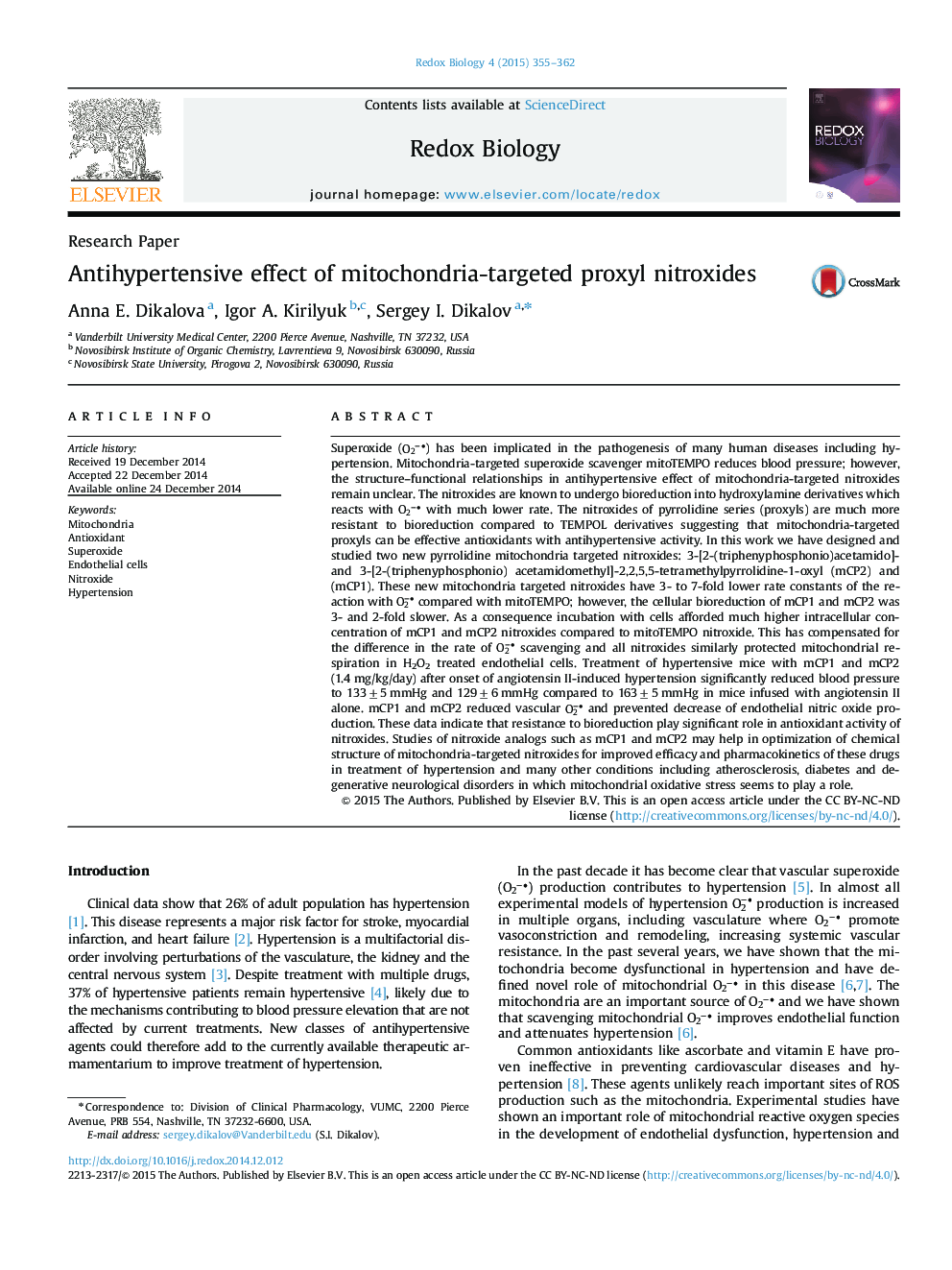| کد مقاله | کد نشریه | سال انتشار | مقاله انگلیسی | نسخه تمام متن |
|---|---|---|---|---|
| 1923102 | 1535846 | 2015 | 8 صفحه PDF | دانلود رایگان |
• Nitroxides bioreduction into hydroxylamine can reduce their antioxidant properties.
• Mitochondria-targeted proxyls are more resistant to bioreduction vs mitoTEMPO.
• Intracellular concentration of mCP1 and mCP2 nitroxides is higher vs mitoTEMPO.
• mCP1 and mCP2 diminished vascular superoxide and reduced hypertension.
Superoxide (O2-
• O2-
• ) has been implicated in the pathogenesis of many human diseases including hypertension. Mitochondria-targeted superoxide scavenger mitoTEMPO reduces blood pressure; however, the structure–functional relationships in antihypertensive effect of mitochondria-targeted nitroxides remain unclear. The nitroxides are known to undergo bioreduction into hydroxylamine derivatives which reacts with O2-
• O2-
• with much lower rate. The nitroxides of pyrrolidine series (proxyls) are much more resistant to bioreduction compared to TEMPOL derivatives suggesting that mitochondria-targeted proxyls can be effective antioxidants with antihypertensive activity. In this work we have designed and studied two new pyrrolidine mitochondria targeted nitroxides: 3-[2-(triphenyphosphonio)acetamido]- and 3-[2-(triphenyphosphonio) acetamidomethyl]-2,2,5,5-tetramethylpyrrolidine-1-oxyl (mCP2) and (mCP1). These new mitochondria targeted nitroxides have 3- to 7-fold lower rate constants of the reaction with O2-
• compared with mitoTEMPO; however, the cellular bioreduction of mCP1 and mCP2 was 3- and 2-fold slower. As a consequence incubation with cells afforded much higher intracellular concentration of mCP1 and mCP2 nitroxides compared to mitoTEMPO nitroxide. This has compensated for the difference in the rate of O2-
• scavenging and all nitroxides similarly protected mitochondrial respiration in H2O2 treated endothelial cells. Treatment of hypertensive mice with mCP1 and mCP2 (1.4 mg/kg/day) after onset of angiotensin II-induced hypertension significantly reduced blood pressure to 133±5 mmHg and 129±6 mmHg compared to 163±5 mmHg in mice infused with angiotensin II alone. mCP1 and mCP2 reduced vascular O2-
• and prevented decrease of endothelial nitric oxide production. These data indicate that resistance to bioreduction play significant role in antioxidant activity of nitroxides. Studies of nitroxide analogs such as mCP1 and mCP2 may help in optimization of chemical structure of mitochondria-targeted nitroxides for improved efficacy and pharmacokinetics of these drugs in treatment of hypertension and many other conditions including atherosclerosis, diabetes and degenerative neurological disorders in which mitochondrial oxidative stress seems to play a role.
Figure optionsDownload as PowerPoint slide
Journal: Redox Biology - Volume 4, April 2015, Pages 355–362
